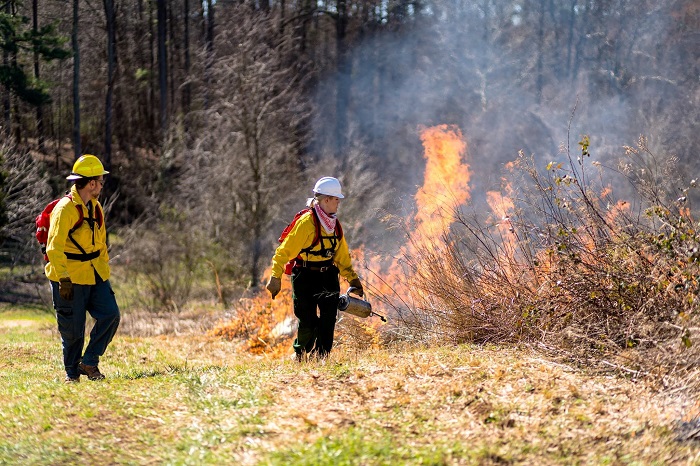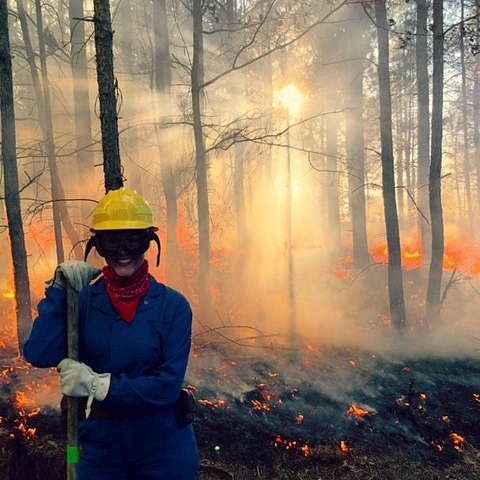A Fiery Passion: My Experience with Prescribed Burning
For immediate release ‐ October 10, 2019
Contact: Jessica Wackes, 919.707.9850. Images available upon request
By Erin Apple, NCMNS Educator, and facilitated by Jess Wackes, PR & Marketing Coordinator

Like most Americans, I was raised with the classic narrative to “prevent fires at all costs.” While this is sound advice for protecting human property in the short term, many of our threatened and endangered species and southeastern ecosystems depend on fire. So, how do we protect these fire-dependent ecosystems without causing damage to homes and property? The answer is prescribed burning.
CATCHING THE FIRE BUG
I’ll never forget how I felt at my first burn. I was fresh out of college and working at a nature preserve in Charlotte when I participated in a prescribed burn of 60 acres of restored prairie land. Piedmont prairie is a fire-dependent ecosystem that, like the longleaf pine savannahs of the southeast, was largely wiped out when European settlers arrived in this area and began suppressing fires to protect their newly built houses, towns and agricultural land.
Prior to settlement, nomadic American Indian tribes would encourage the spread of natural fires, lit by lightning or even the tribes themselves as they managed the land to support the herds of bison they depended on. As fires were suppressed and bison were wiped out, prairies grew into dense forests. Unsustainable logging and fire suppression demolished the fire-dependent longleaf pine down to an estimated 3% of its former range. The North Carolina we know today looks very different than it did just a few hundred years ago.
Seeing as I had no experience, I was assigned to the simplest of burn crew tasks – manning a utility vehicle and water tank in case of emergency. I remember feeling completely fascinated by the process. Prescribed burns prevent prairies from growing into forests, control invasive species and return nutrients to the soil to fertilize fresh growth of beneficial native grasses and plants. Not only is fire itself incredible to watch, but the feeling of seeing conservation in action was deeply humbling. I was hooked.

DEEPENING MY TRAINING
I spent the next several years working with education and natural resource management in various state and county parks to get as much prescribed burning experience as I could. I went from pulling the water tank to prepping burn units and learning the equipment, to manning fire lines, and finally to holding the drip torch and lighting lines of fire (an undeniably thrilling experience).
When I came to this Museum as an educator, I began pursuing my N.C. burn certification to broaden the Museum’s educational resources about fire. On February 14th of this year, after taking classes and helping with burns and planning, I served as head of a burn crew at Prairie Ridge to complete my certification.
CONSERVATION AND EDUCATION
While burning itself is fun, participating in conservation in action is inspiring. Prairie Ridge provides a unique opportunity to see land management in action in an urban area. It also stimulates important conversations about the need to restore and care for historic, threatened ecosystems that our most vulnerable wildlife depends on.
With the spread of development and increasing industrialization, we are left with a choice: we as humans can continue to manipulate the environment at the expense of our natural resources, or we can use our ever-expanding knowledge and our unique power to protect these resources. My choice will always be conservation, not just for the benefit of wildlife, but for the people who depend on a healthy planet.
I’ll raise my torch to that.

At NCMNS, we facilitate prescribed burns annually at our Prairie Ridge location. Members receive email alerts to when burns are scheduled so they can come and watch! Become a member and experience more with the Museum.
For more information about our upcoming activities, conservation news and ground-breaking research, follow @NaturalSciences on Instagram, Twitter and Facebook. Join the conversation with #visitNCMNS.

